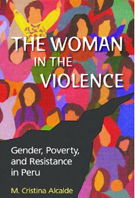Cristina Alcalde’s book, "The Woman in the Violence: Gender, Poverty, and Resistance in Peru," recently published through Vanderbilt University Press, addresses the different types of violence women experience during different stages of their lives. In writing The Woman in the Violence, Alcalde, an Assistant Professor in the Gender and Women’s Studies Department at the University of Kentucky, drew from her extensive fieldwork conducted in Lima, Peru, the capital of Peru and one of the largest cities in Latin America. Alcalde focuses on the everyday activities of women affected by violence and examines what happens before, throughout, and after abusive relationships. In addition, her analysis addresses multiple forms of violence, from structural, to institutional, to interpersonal, and it showcases not only how violence acts upo

n women but also how women are acting against violence.
One of Alcalde’s goals with The Woman in the Violence is to make familiar the “largely unfamiliar setting in which women’s lives unfold in Lima” and to make visible the “largely invisible and intersecting forms of violence women experience, as well as the strategies women create to
resist violence.” Alcalde suggests that in order to create a “more holistic portrait of women’s lives,” those researching the impact of, and resistance to, violence should “analyze women’s experiences of intimate partner violence as these intersect with other forms of violence, such as institutional and structural violence.”
 Alcalde also stresses that, although “women’s gender is a significant source of subordination,” it is by no means “the only or perhaps even the most significant identity marker that shapes women’s experiences of violence.” For instance, in Lima, she argues that “race, class, and geographical location” are all significant factors. Thus, in The Woman in the Violence, Alcalde not only showcases the intersection of interpersonal, structural and institutional violence, but she also highlights how the intersection of gender, race, class, and geography in shape women’s experiences of those multiple forms of violence.
Alcalde also stresses that, although “women’s gender is a significant source of subordination,” it is by no means “the only or perhaps even the most significant identity marker that shapes women’s experiences of violence.” For instance, in Lima, she argues that “race, class, and geographical location” are all significant factors. Thus, in The Woman in the Violence, Alcalde not only showcases the intersection of interpersonal, structural and institutional violence, but she also highlights how the intersection of gender, race, class, and geography in shape women’s experiences of those multiple forms of violence.
by Christina Buckner
